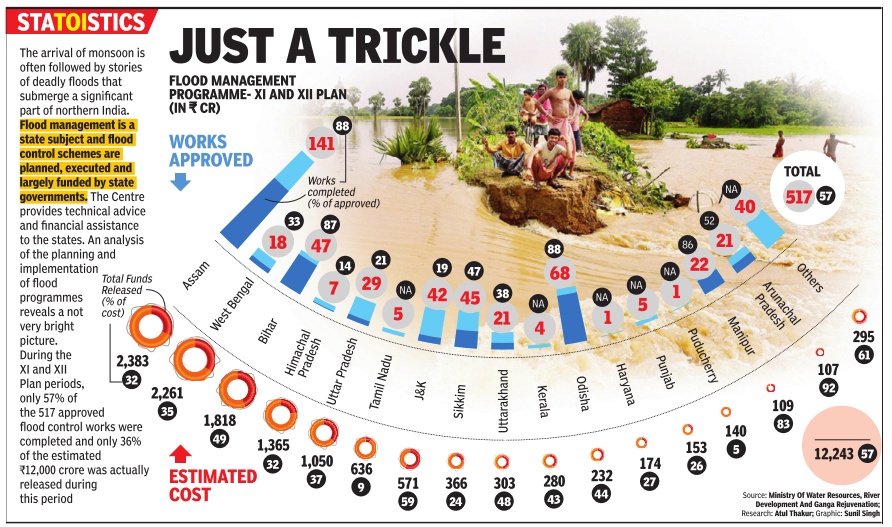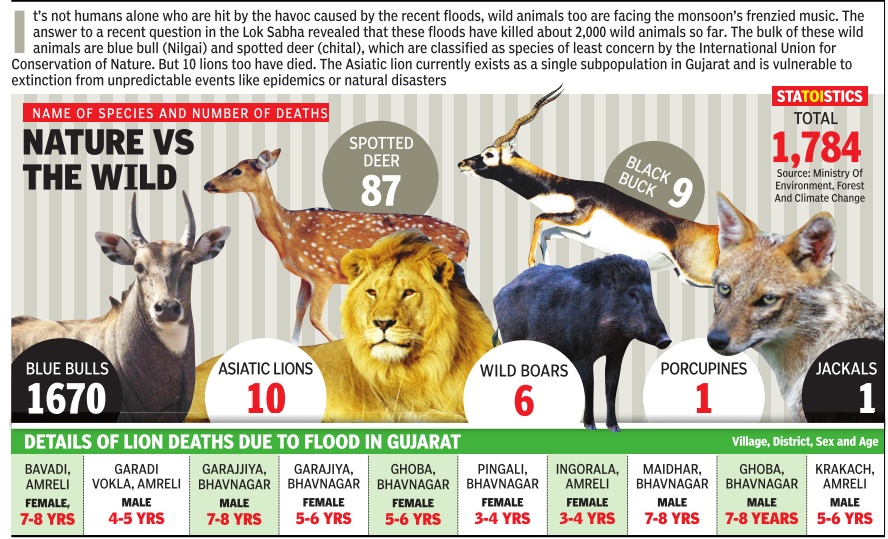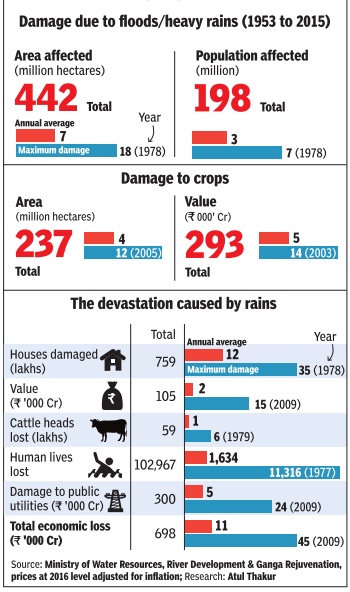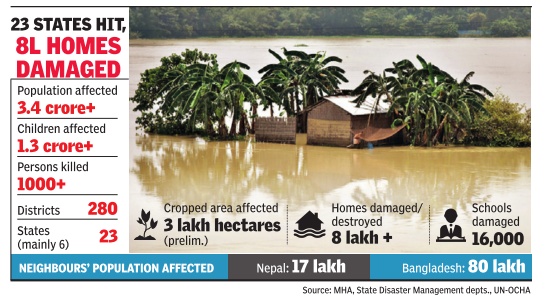Floods in India
This is a collection of newspaper articles selected for the excellence of their content. |

Contents |
The damage caused by floods
Floods affect 3cr Indians every year
Atul Thakur TIMES INSIGHT GROUP 2013/06/20
New Delhi: Chronic floods during the monsoon on an average affect more than 30 million Indians annually. Ironically, 60% of India’s farmland, 66% of its livestock and its entire forest area depend on rains for survival.
Loss to agriculture and livestock
According to a recently released Central Water Commission (CWC) report, on an average 7.21 million hectares (roughly 72,000 sq km) go under floodwater. This water typically ravages 3.78 million hectares of agricultural land, damaging crops worth Rs 1,118 crore annually. Heavy rains and floods account for nearly 1,700 lives lost annually. Apart from this, 1.25 lakh houses are annually damaged by torrential rains that also wipe out nearly 96,000 livestock.
Floods are the most recurrent natural calamity, hitting India almost every year. According to the CWC’s report on “financial aspects of flood control, anti-sea erosion and drainage projects”, it is not possible to provide absolute protection instantly to all flood-prone areas. It says that such an attempt will neither be practical nor economically viable.
Marginal decline in flood-affected areas since 1953
The CWC’s analysis of floods in India from 1953 to 2011 shows a marginal decline in flood-affected areas over the years. The data shows 1977, 1978 and 1979 were the worst-hit. The 1977 floods killed over 11,000 people — six times the average for the 59 years between 1953 and 2011. In terms of area and population affected, the floods of 1978 were most destructive.
Financial loss
In terms of financial loss, recent floods have been far more destructive. The total loss of crops, houses and public utilities in 2009 was Rs 32,541 crore, the highest for any year. The 2003 floods destroyed crops worth Rs 7,298 crore, while the flood-induced damage to houses was more than Rs 10,000 crore in 2009, the maximum so far.
The report shows there was a continuous increase in the population affected till the mid-eighties; thereafter, the number has slowly declined
Animals killed in Indian floods

2015
November-December floods in South India: Economic loss
Oneindia, December 10, 2015
Oneindia
Floods cause $3 bn loss in India in Nov-Dec, says Aon Benfield
Torrential rains, which caused floods in South India in November and early-December, has led to economic losses to the tune of USD 3 billion (about Rs 20,000 crore), a report said today.
According to reinsurance broker Aon Benfield's monthly Global Catastrophe Recap report, economic developments in Asia are taking place in flood plains and marsh lands with scant attention to drainage, thus increasing run-off and flooding.
An enhanced North East monsoon impacted by the current El Nino brought weeks of torrential rainfall to southern India and Sri Lanka for much of November into early December, the report said.
Portions of Tamil Nadu and Andhra Pradesh in India and Sri Lanka were heavily impacted by floods. There were severe impact to agricultural interests and infrastructure as rivers swelled into both rural and urban areas. Chennai metropolitan region was particularly damaged by the event, it added.
"Total economic losses in India were estimated to reach as high as Rs 200 billion (USD 3 billion). India's General Insurance Corporation claims possibly reaching up to Rs 20 billion (USD 300 million)," it revealed. Aon Benfield's report evaluates the impact of the natural disaster events that occurred worldwide.
The firm's Head of Impact Forecasting Asia Pacific Adityam Krovvidi says that scant attention to drainage while pursuing economic developments in Asia is also a major cause of flooding.
"The 100-year rainfall event in Chennai exposed the inherent weakness of the one-dimensional nature of this economic pursuit and highlights the need for serious introspection, implementation of mitigation measures and the redesign of urban landscapes," he added. Risk assessment can play a major role in awareness and insurance in mitigating the financial hardships.
The large gap between the economic and insured loss from the Chennai flood event further emphasises the need for greater insurance penetration in large industrialized cities in Asia, he said. "This will become even more important as Asian megacities continue to grow and the risk of major urban flood events increases," Krovvidi said.
Damage due to floods/ heavy rains: 2015
The Times of India, August 27, 2016

Every year around three crore people get affected by floods. At inflation-adjusted 2016 prices, the average annual loss because of floodsheavy rains works out to 11,000 crore. Apart from that more than a thousand lives are also lost. So far floods have killed more than one lakh people in the country. While the 1970s recorded the worst in terms lives lost and houses damaged, the economic loss is higher in recent years because of damage to public utilities
2016
Assam: till June
The Times of India, Jun 23 2016
Prabin Kalita
9,000 hit in year's 2nd wave of floods in Assam
The floods had affected over 9,000 people, the Assam State Disaster Management Authority said. Nearly 29 villages have been inundated in the affected districts, Lakhimpur, Dhemaji and Karbi Anglong, and over 2,000 hectares of crop area flooded, the authority added. More than 8,000 people have been affected in Dhemaji alone. The eastern district, located on the northern bank of the Brahmaputra, is usually the worst flood-hit district every year.A flood warning has been issued for Majuli island.
The first wave of floods in April affected nearly one lakh people and killed nine.
In a related report, repeated landslides on the LumdingSilchar hill section of the Northeast Frontier Railway have cut off a large part of the northeast for the past 36 days.
2017
Worst floods in a decade
Subodh Varma, Floods in 2017 worst in a decade, Sep 6, 2017: The Times of India

Over 1,000 Dead, 3.4 Crore People Affected
As the monsoon prepares to recede, India faces a mammoth recovery task from the worst floods in a decade. Over 3.4 crore people across 280 districts have been affected by floods that left more than 1,000 dead.
Very preliminary estimates indicate that over 3 lakh hectares of crops, mainly paddy , have been destroyed. Over 8 lakh homes, mostly kachcha units have been damaged or destroyed. An estimated 16,000 schools too have suffered damage. The vast network of state-run health centres in far-flung rural areas has also suffered extensive damage although concrete numbers are not available.
Records show this year's monsoon floods were the worst since 2007, when 4.1 crore people were affected.
The past few days have brought some respite as most rivers in UP, Bihar and West Bengal are now flowing at normal levels and rainfall too has been scattered or isolated, although it continues in Assam and adjoining states. Flood waters are reportedly receding across the affected swathe but lakhs of people continue to receive food and other essentials from relief camps and community kitchens set up by state governments.
The immediate issue will be preventing the spread of diseases, especially waterborne ones such as diarrhoea, and mosquito-borne ones like dengue, malaria and encephalitis, warn experts.Subsequently , the onerous task of recovery faces the affected people who are mostly dependent on agriculture.
The flooding was mainly in UP, Bihar, north Bengal, Odisha and Assam. Although most of these states received normal or even slightly below par rainfall this monsoon season, rivers flowing down from the Himalayas were in spate because of heavy rains in the mountains and upper catchment areas.
Excess rains caused unprecedented flooding in Gujarat, Rajasthan and parts of western Maharashtra, including Mumbai. IMD offi cials say that nearly all floodprone areas in the country have experienced flooding at some point this season.
The same rivers -Brahmaputra and Ganga with their numerous tributaries -which inundated the northern and eastern plains caused flooding in downstream Bangladesh, affecting 80 lakh people in 32 districts.
Meanwhile, upstream catchment areas falling in Nepal experienced some of the worst floods with 17 lakh people impacted in 35 districts of the country . Over 140 people have perished in the floods and an estimated $8.8 billion worth of crops destroyed, mainly in the terai districts of Nepal. While Pakistan has not been as extensively affected, 136 persons have lost their lives in heavy rains and floods in Sindh and Balochistan.
The death toll in these devastating floods across the subcontinent has crossed 1,200 and the population affected is 4.5 crore, according to UN agencies, making 2017 monsoon floods one of the most destructive.
`Primitive methods led to Bihar flood deaths'
Pradeep Thakur, `Primitive methods led to Bihar flood deaths', Sep 19, 2017: The Times of India
Primitive embankment management and reluctance of villagers to evacuate even when flood waters crossed the danger level were prime reasons behind the death of more than 500 people in Bihar, a top National Disaster Management Authority (NDMA) official said.
The Centre last week sent NDMA member Kamal Kishore to tour the flood-affected districts of Bihar and assess local fault lines and find out why the state, which has been at the forefront of implementing disaster management initiatives, failed to stem the rising casualties despite the fact that severe climate events are not new in Bihar.
Kishore told TOI that district administrations still relied on primitive means like officials taking rounds of the embankments on a river flowing above the danger level on vehicles to assess the threat level rather than utilising modern early warning system techniques.
“District authorities in the affected region have not yet installed sensors along the embankments that could send out signals to the control rooms during an embankment breach,“ Kishore said. This, despite the fact that most casualties occur due to breach in embankments and the sudden inundation of villages.
More than 1.72 crore people were affected by floods this monsoon. According to Bihar's estimates, as on September 4, more than 8.55 lakh people were evacuated from flood-affected areas.The state is running over 1,600 community kitchens in at least 1,358 relief camps.The state government is feeding two meals daily to over 5.57 lakh people uprooted.
About 17 districts have reported 514 casualties and 4.22 lakh people are still living in relief camps. The state disaster response force had deployed 16 teams with 92 boats to evacuate people. But that was not adequate as almost 9 lakh people needed to be rescued .The NDRF pitched in with 18 teams. Kishore said the state needed to modernise its embankment management and use latest technology such as sensors along the embankment in sensitive zones
See also
Floods in India
